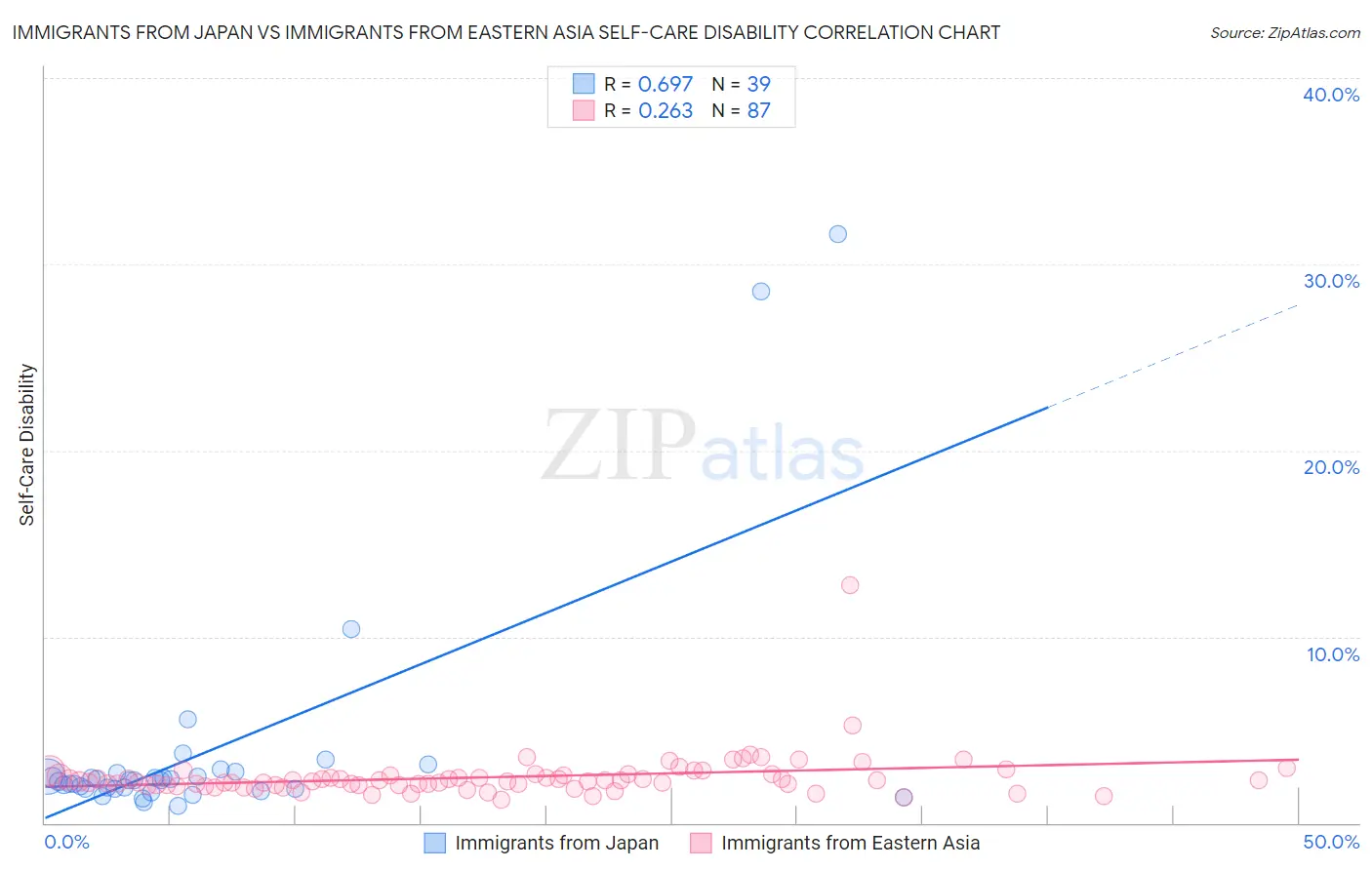Immigrants from Japan vs Immigrants from Eastern Asia Self-Care Disability
COMPARE
Immigrants from Japan
Immigrants from Eastern Asia
Self-Care Disability
Self-Care Disability Comparison
Immigrants from Japan
Immigrants from Eastern Asia
2.3%
SELF-CARE DISABILITY
99.5/ 100
METRIC RATING
60th/ 347
METRIC RANK
2.3%
SELF-CARE DISABILITY
99.6/ 100
METRIC RATING
56th/ 347
METRIC RANK
Immigrants from Japan vs Immigrants from Eastern Asia Self-Care Disability Correlation Chart
The statistical analysis conducted on geographies consisting of 339,768,160 people shows a significant positive correlation between the proportion of Immigrants from Japan and percentage of population with self-care disability in the United States with a correlation coefficient (R) of 0.697 and weighted average of 2.3%. Similarly, the statistical analysis conducted on geographies consisting of 498,784,533 people shows a weak positive correlation between the proportion of Immigrants from Eastern Asia and percentage of population with self-care disability in the United States with a correlation coefficient (R) of 0.263 and weighted average of 2.3%, a difference of 0.33%.

Self-Care Disability Correlation Summary
| Measurement | Immigrants from Japan | Immigrants from Eastern Asia |
| Minimum | 0.90% | 1.2% |
| Maximum | 31.6% | 12.8% |
| Range | 30.7% | 11.5% |
| Mean | 3.9% | 2.5% |
| Median | 2.3% | 2.2% |
| Interquartile 25% (IQ1) | 1.8% | 2.0% |
| Interquartile 75% (IQ3) | 2.7% | 2.6% |
| Interquartile Range (IQR) | 0.86% | 0.53% |
| Standard Deviation (Sample) | 6.4% | 1.3% |
| Standard Deviation (Population) | 6.3% | 1.3% |
Demographics Similar to Immigrants from Japan and Immigrants from Eastern Asia by Self-Care Disability
In terms of self-care disability, the demographic groups most similar to Immigrants from Japan are Palestinian (2.3%, a difference of 0.10%), New Zealander (2.3%, a difference of 0.14%), Egyptian (2.3%, a difference of 0.19%), Immigrants from Cameroon (2.3%, a difference of 0.25%), and Mongolian (2.3%, a difference of 0.27%). Similarly, the demographic groups most similar to Immigrants from Eastern Asia are Immigrants from Belgium (2.3%, a difference of 0.010%), Immigrants from France (2.3%, a difference of 0.040%), Immigrants from Cameroon (2.3%, a difference of 0.080%), Argentinean (2.3%, a difference of 0.10%), and Australian (2.3%, a difference of 0.15%).
| Demographics | Rating | Rank | Self-Care Disability |
| Immigrants | Malaysia | 99.7 /100 | #48 | Exceptional 2.3% |
| Latvians | 99.7 /100 | #49 | Exceptional 2.3% |
| Immigrants | Brazil | 99.7 /100 | #50 | Exceptional 2.3% |
| Kenyans | 99.7 /100 | #51 | Exceptional 2.3% |
| Immigrants | Serbia | 99.6 /100 | #52 | Exceptional 2.3% |
| Australians | 99.6 /100 | #53 | Exceptional 2.3% |
| Argentineans | 99.6 /100 | #54 | Exceptional 2.3% |
| Immigrants | France | 99.6 /100 | #55 | Exceptional 2.3% |
| Immigrants | Eastern Asia | 99.6 /100 | #56 | Exceptional 2.3% |
| Immigrants | Belgium | 99.6 /100 | #57 | Exceptional 2.3% |
| Immigrants | Cameroon | 99.6 /100 | #58 | Exceptional 2.3% |
| New Zealanders | 99.5 /100 | #59 | Exceptional 2.3% |
| Immigrants | Japan | 99.5 /100 | #60 | Exceptional 2.3% |
| Palestinians | 99.4 /100 | #61 | Exceptional 2.3% |
| Egyptians | 99.4 /100 | #62 | Exceptional 2.3% |
| Mongolians | 99.3 /100 | #63 | Exceptional 2.3% |
| Swedes | 99.3 /100 | #64 | Exceptional 2.3% |
| Brazilians | 99.3 /100 | #65 | Exceptional 2.3% |
| Immigrants | Argentina | 99.3 /100 | #66 | Exceptional 2.3% |
| South Africans | 99.3 /100 | #67 | Exceptional 2.3% |
| Immigrants | Zaire | 99.2 /100 | #68 | Exceptional 2.3% |